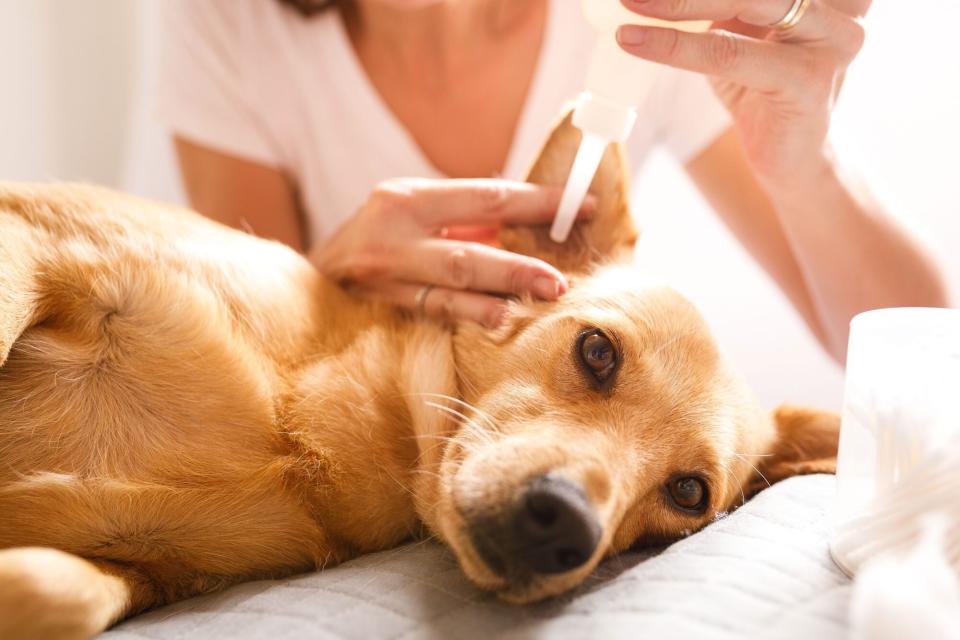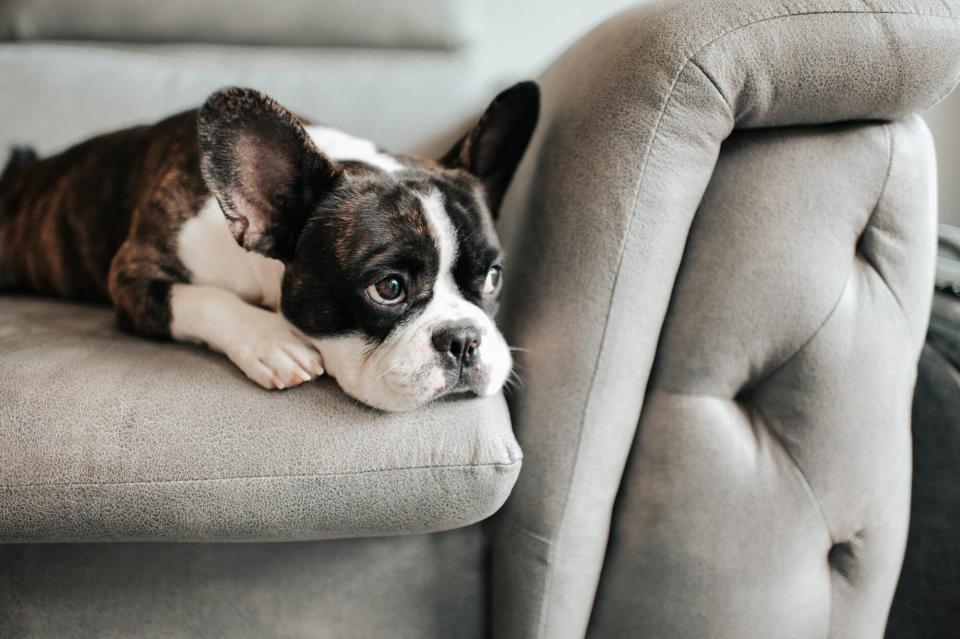How to Clean Your Dog's Ears the Right Way, According to Veterinarians
TABLE OF CONTENTS
On This Page
Dog Ear Cleaning 101
Cleaning Frequency
Signs It's Time for an Ear Cleaning
Keeping Dogs Comfortable
How to Clean a Dog's Ears
When to Seek Professional Care
Your dog is a cherished member of your family, which is why you pay such close attention to their needs—just like you would for any loved one. And while bath time, regular walks, and check-ups at the vet are key elements of their care, there are a few other tasks that should be on your radar, including routine ear cleanings. This often overlooked grooming step is essential and will help you avoid everything from infections to general discomfort. To help you figure out when and how to clean your dog's ears, we tapped veterinarians to break down the entire process.
Related: Spoil Your Four-Legged Friend with Some of Martha's Very Best Products for Pet Owners

GETTY IMAGES
Why It's Important to Clean Your Dog's Ears
Simply put, cleaning your dog's ears is necessary for their health. Their ears are a breeding ground for bacteria, yeast, and mites, which grow and multiply in the warm, moist environment, says Alysper Cormanes, DVM, a veterinarian affiliated with Veterinarians.org. "Just like us, our dogs make earwax that is essentially a protective, 'self-cleaning' agent for the ears, but it can be produced in excess when there is an underlying condition, such as in the case of infections, parasites, and allergies," she says.
How Often to Clean Your Dog's Ears
As a rule of thumb, clean your dogs' ears no more than once each month. However, ear inspection should take place weekly so you can spot any abnormal symptoms as they arise. "Dogs have natural flora inside of their ears that, if disrupted due to overcleaning, will still instead lead to infection," says Dr. Cormanes. "It is also good to clean your dog's ears after each bath, or any water activities like swimming. Water can get into their ears and that excess moisture will allow for bacterial overgrowth."
There are a few other factors to consider when establishing an ear cleaning cadence. Dogs that have floppy or hanging ears, swim regularly, or have underlying allergies are more prone to infection, says Carly Fox, DVM, senior veterinarian at Schwarzman Animal Medical Center. Always consult your veterinarian on a recommended cleaning cadence if your dog falls in any of these categories, she notes.
If your dog's ears become smelly, irritated, or inflamed just a few days after their monthly cleaning (or you feel like they need more than one ear cleaning per month), there might be an underlying issue at play—one that needs to be addressed by a veterinarian, Dr. Cormanes notes.

Signs That You Need to Clean Your Dog's Ears
These signs indicate that your pup is ready for that monthly ear cleaning.
Foul Odor
Healthy ears shouldn't have a musty or a "sickeningly sweet" odor, says Dr. Cormanes. "This smell is a definite sign of an infection that could have been brought about by an over-proliferation of yeast, bacteria, or a combination of both," she says. "In such cases, you should not only clean their ears, but also take them to the veterinarian for follow-up medication that will treat the cause of the smell."
Consistent Head Shaking or Ear Rubbing
Head shaking and ear rubbing are signs of discomfort—and are likely an attempt to alleviate it. If you see dogs doing this, take a peek inside their ears. "If their ears look dirty, give them a good clean and assess other factors such as: Does the ear look inflamed or painful? Is the ear itchy even after cleaning? Does the problem come back even after cleaning?" says Dr. Cormanes. "If the answer to any of those questions is yes, then you will definitely need to go get it checked by the veterinarian, as they may be an indicator of an underlying issue."
Visible Ear Discharge
Ears will always need a cleaning if you see discharge, which is the visible accumulation of debris or earwax. "You will need to pay close attention to the color and consistency of the earwax," says Dr. Cormanes. "Normal earwax should be pale and yellowish in color and should not smell bad."
If your dog's earwax is brown or red, they could have an ear mite infection; earwax that is green or gray could be a sign of a bacterial or yeast infection. "Additionally, if you notice that your dog's ears are too moist or even wet, that may be a sign that there is an overproduction of earwax due to an underlying issue," she says. "Try to get out as much of the dirt and debris as possible and take your dog to see a veterinarian."

Edwin Tan / Getty Images
How to Introduce Ear Cleaning to Dogs
Ear cleaning is inevitably an uncomfortable process for dogs, so it's best to go slow and make the experience as positive as possible, says Heather Berst, VMD, the senior medical lead at Zoetis. "Even make them seeing the ear cleaner and the ear cleaning supplies a positive experience," she says. "Give them treats, praise them, and make it fun and relaxed as you get supplies ready each time."
Follow Dr. Berst's steps to introduce ear cleaning to your dog:
Start off in a calm, quiet location where your dog is relaxed.
Begin scratching them and petting them and slowly move your hands to touch their ears and then give them a treat or praise them. Do this several different times until they are used to you touching their ears.
As you begin to clean the ears the first few times, use something to distract the dog. Something they like to lick, such as some peanut butter (without any artificial sweetener) on a spoon works well.
Consider having a second person hold the spoon for the dog to lick as you work on their ears.
If your dog is not food motivated, give them a toy they like or praise them during the process.
Keep the initial ear cleaning sessions brief until your pet adjusts to it.
Related: The Most Effective Natural Home Remedies for Your Pet
How to Clean a Dog's Ears
Aside from cleaning solutions specifically formulated for dogs, like Virbac Epi-Otic Advanced Ear Cleanser for Dogs, you can dilute vinegar to make a DIY dog ear cleaner, says Jacqueline Brister, DVM, a veterinarian and consultant for Embrace Pet Insurance. Your solution should contain less than 25 percent vinegar, so you'll need 1 part vinegar and 3 parts water. Never use hydrogen peroxide and alcohol for ear cleaning; they can damage the ear canal and cause overall discomfort, she warns.
Only Clean the Outer Ear
Note the only area that you should be cleaning: the outer ear. "Dogs' ears are made of three essential components: the outer ear canal, middle ear, and inner ear which all make sort of an 'L' shape," says Dr. Cormanes. The part of the ear that we usually see is called the pinna or the outer ear; this is the area you should clean. "This unique anatomy makes it difficult for them when material is trapped deep within the horizontal inner canals and cannot be expelled without our assistance," she says.
Materials You'll Need
Vinegar solution
Cotton balls or cloth
Follow these expert-approved steps to clean a dog's ears:
Gently fill up the ear canal with cleaning solution.
Lightly massage the outside base of the ear to help break up the wax inside the ear canal.
Clean out excess moisture and wax gently with cotton balls or a cloth. Do not use cotton swabs or stick your fingers into the dog's ear canal; this can damage the canal or ear drum.
Reapply cleaner one or two more times until all the wax and debris has been flushed out.
Wipe the inside of the pinna (ear flap) thoroughly with cotton balls.
Clean and dry your pet's face, ears, and neck after you're done. Ear cleanings can get messy, so dogs tend to shake their heads a lot to get rid of the extra moisture in their ears afterwards.
When to Visit Your Veterinarian for a Professional Ear Cleaning
If you think your dog still has wax buildup after cleaning their ears several times, seek professional veterinary care. "Some dogs require a deep cleaning procedure in which the ear is flushed while the dog is under sedation," says Dr. Brister. "Other times to seek veterinary care include when the ear is painful, swollen, red, has sores on it, has pus or bloody discharge, or the dog shakes his or her head constantly."
Ear Conditions
Dogs can get a hematoma on their ear if they hit it or scratch it too much, says Dr. Berst. "It is caused by a blood vessel breaking and cause heat and swelling," she says. This can make your dog's ear look like a swollen, hot balloon. She advises visiting the veterinarian for treatment.
If the ear drum ruptures, it can also be dangerous to clean the ear. "Many cleaning solutions are not safe for use in dogs with ruptured ear drums, as the dog may become deaf," says Dr. Brister. "The only way to know if an ear drum is ruptured is to examine it with an otoscope, which is most easily done by a licensed veterinarian at the veterinarian's office (viewing the ear drum with an otoscope in an awake, wiggly dog takes lots of practice)."

